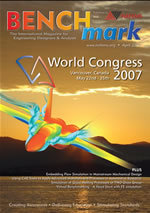BENCHmark April 2007
A Truly Global Industry

In this Issue:
Earlier this year, I had the privilege of travelling to India to visit a number of the companies there that are making extensive use of CAE. I was very intrigued about the visit – I had heard many stories about what is happening there and the tremendous growth in the use of engineering analysis.
However, nothing could have prepared me for the experience. The extent of CAE usage that I witnessed was staggering. That I had expected. What I had not bargained on was the overwhelming enthusiasm and the passion for a career devoted to CAE that I came across time and again. This was truly breathtaking, and highly refreshing.
This booming time for Indian CAE engineers is very heavily based upon work which has been subcontracted to India by Western companies. What does this mean for the global analysis community? Many engineers in the West fear the changes that are taking place, and the reasons for this are well founded and clearly understandable. But, realistically, in an increasingly global marketplace, I believe that any attempts to prevent this will be futile. Rather, we should all embrace the opportunities that are unfolding as a consequence of these changes. I have yet to meet a group of people that are more enthusiastic about our branch of technology than those I met whilst in India. Through the explosion in the use of simulation in the region, the talent pool of experienced CAE professionals there is rapidly growing. This must ultimately be good news for the entire profession, helping to overcome the limiting factor of available personnel, and allowing simulation to be used much more extensively.
So, what about a role for NAFEMS? Well, the primary interest in NAFEMS from engineers in India is twofold: training and certification. To service the growth in CAE in India, the industry needs to recruit 20,000+ new engineers each year to carry out simulation work. Industry recognises that, if these new recruits are to perform their work competently, they must receive high quality training. Can NAFEMS help with this? Can we set the training standards through defining learning outcomes, can we “train the trainers” and/or endorse those who provide the training? And, finally – certification of analysts. Western companies outsourcing work to India have a keen interest in determining the competence of all those who will be working for them. Equally, those aspiring to a long and fruitful career in engineering analysis want a means by which they can differentiate themselves from their colleagues and demonstrate their prowess and their skills – this certainly sounds like a role for a Registered Analyst scheme!
Tim Morris, Chief Executive
April 2007



